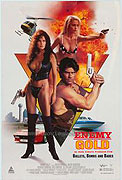
Regie:
Christian Drew SidarisKamera:
Mark MorrisMusik:
Ron Di IulioBesetzung:
Bruce Penhall, Mark Barriere, Julie Strain, Suzi Simpson, Tanquil Lisa Collins, Rodrigo Obregón, Kym Malin, Andy SidarisInhalte(1)
While on suspension from their jobs as government operatives, a trio of female agents decides to investigate the legend of Quantrill's hidden gold that he and his Raiders hid at the end of the Civil War. (Verleiher-Text)
Kritiken (1)
The Sidaris family fell into destitution. The central star of their seven previous films, as well as the systematically constructed universe bound to her, chose motherhood for a career and sent shockwaves through the world of magnetic tape. In addition to that, their trademark picturesque environments of sun-drenched beaches, scantily clad centrefolds and juvenile action not only got bogged down in repetition, but mainly lost their uniqueness. Whereas this combination was a spluttering novelty that could survive thanks to the global video market at the end of the 1980s, these Sidaris attributes were appropriated by the mainstream with the advent of the early 1990s as the most credulous, debauched and completely undiscerning era of pop culture. Recall that playmate Pamela Anderson shone in the third season of Baywatch in 1992, while shows like Tropical Heat and Renegade provided action amusements on the small screen, joined by Walker, Texas Ranger in 1993. The video market was also transformed, as younger predatory fish, with PM Entertainment at the fore, fought for viewers’ attention and well-established purveyors of trash such as Action International Pictures attempted to counter them with more expensive projects and the major studios were breathing down the back of everyone’s neck with their own straight-to-video productions. The confluence of these and other factors led to the fact that the Sidaris family business essentially tightened its belt and then transformed itself into the new production company Skyhawks Films (Malibu Bay Films remained only as a distribution company), and while the patriarch Andy gathered strength for more original projects, his son Christian Drew Sidaris followed in his footsteps. _____ In and of itself, Enemy Gold is not a disaster, though it’s nothing to write home about, either. In contrast to previous Sidaris films, it comes across as disturbingly modest, dry and futile. The photogenic exotica of Hawaii was replaced with generic exteriors from an audio-visual bank and the dirty realities of Louisiana. The non-stop promenade of characters and a variety of centrefold models was replaced by a constricted cast limited to seven characters and a few one-scene bit parts. Above all, the childish guilelessness almost entirely disappeared along with the playing with Bond-esque gadgets and remote-control toys and even all exaggeration. The overall pared-down nature of the production finally becomes apparent in the explosions and shootouts, as well as in the constituent locations of the film, hence the shift of the action in the second half to a forest, i.e. to an environment traditionally used mainly by amateur productions with zero budget. The only thing reminiscent of the old days of Sidaris movies is a few silicone ladies, boudoir-lit make-out sessions and an appropriately hollow script with obvious straightforward twists (the coincidences leading to the discovery of the treasure from the Civil War are outlandish). But it’s still not the bottom of the barrel (that would be the boring Savage Beach), but the bitterness of society and the film universe, which found themselves in limbo, hangs over the whole project. Julie Strain and Suzi Simpson greatly elevate the whole work idling in neutral, but they can’t save it. _____ In the context of the Sidaris MCU (Mammaries Cinematic Universe), we can refer to this film as the first title in Phase 3, following the example of categorising Marvel movies. This is defined by production under the banner of the newly established Skyhawks Films. Besides Sidaris’s loyal players, led by Rodrigo Obregón, only the worn-out Bruce Penhall remained from the main actors from the preceding phase. Following the example of previous projects, Enemy Gold was made as a dual production together with The Dallas Connection. When comparing it to this noticeably more ambitious second film, it seems that Enemy Gold was made a bit outside the framework for using the locations and actors, but the greater part of the funding was swallowed up by The Dallas Connection.
()
(weniger)
(mehr)